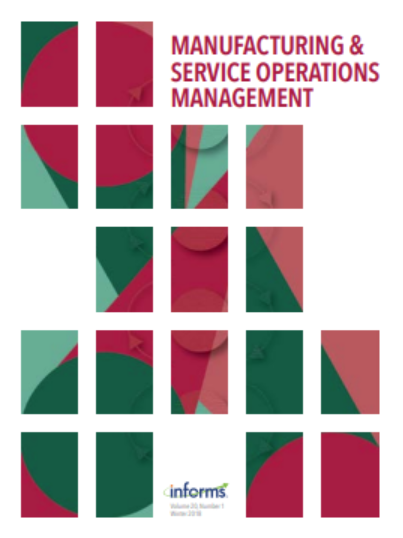具有战略驱动的网约车:平台控制能力对性能的影响
IF 4.8
3区 管理学
Q1 MANAGEMENT
M&som-Manufacturing & Service Operations Management
Pub Date : 2023-09-01
DOI:10.1287/msom.2023.1221
引用次数: 2
摘要
问题定义:在Uber、Lyft和滴滴等网约车平台的激励下,我们研究了空间网络中乘客与自利司机的匹配问题。我们关注两种操作平台控制——需求侧准入控制和供给侧重新定位控制——对性能的影响,考虑到与两个实际重要挑战的相互作用:(i)空间需求不平衡长期存在;(2)自私自利的司机战略性地决定是否加入网络,如果加入,在不为乘客服务时是否重新定位。方法/结果:我们开发并分析了一个新的博弈论流体模型的稳态行为的两个位置,四路由的损失网络。首先,我们充分描述和比较了三种控制下的稳态系统均衡,从最小控制到集中控制。其次,我们提供了关于平台控制如何以及为什么影响均衡绩效的见解,特别是关于准入控制作用的新发现:平台可能会发现,即使司机供应过剩,在低需求位置战略性地拒绝需求也是最优的,以诱导重新定位到高需求位置。我们为这一政策提供了必要和充分的条件。第三,我们推导了平台控制增加所带来的平台和司机利益的上限;在中等容量和显著的跨区位需求不平衡情况下,这一效应更为显著。管理意义:我们的研究结果为网约车网络的优化运营提供了重要的指导。我们的模型还可以为支持更集中的网络控制的驱动补偿结构的设计提供信息。补充材料:电子伴侣和补充材料可在https://doi.org/10.1287/msom.2023.1221上获得。本文章由计算机程序翻译,如有差异,请以英文原文为准。
Ride-Hailing Networks with Strategic Drivers: The Impact of Platform Control Capabilities on Performance
Problem definition: Motivated by ride-hailing platforms such as Uber, Lyft and Didi, we study the problem of matching riders with self-interested drivers over a spatial network. We focus on the performance impact of two operational platform controls—demand-side admission control and supply-side repositioning control—considering the interplay with two practically important challenges: (i) spatial demand imbalances prevail for extended periods of time; and (ii) self-interested drivers strategically decide whether to join the network, and, if so, whether to reposition when not serving riders. Methodology/results: We develop and analyze the steady-state behavior of a novel game-theoretic fluid model of a two-location, four-route loss network. First, we fully characterize and compare the steady-state system equilibria under three control regimes, from minimal control to centralized control. Second, we provide insights on how and why platform control impacts equilibrium performance, notably with new findings on the role of admission control: the platform may find it optimal to strategically reject demand at the low-demand location even if drivers are in excess supply, to induce repositioning to the high-demand location. We provide necessary and sufficient conditions for this policy. Third, we derive upper bounds on the platform’s and drivers’ benefits caused by increased platform control; these are more significant under moderate capacity and significant cross-location demand imbalance. Managerial implications: Our results contribute important guidelines on the optimal operations of ride-hailing networks. Our model can also inform the design of driver compensation structures that support more centralized network control. Supplemental Material: The e-companion and Supplemental Material are available at https://doi.org/10.1287/msom.2023.1221 .
求助全文
通过发布文献求助,成功后即可免费获取论文全文。
去求助
来源期刊

M&som-Manufacturing & Service Operations Management
管理科学-运筹学与管理科学
CiteScore
9.30
自引率
12.70%
发文量
184
审稿时长
12 months
期刊介绍:
M&SOM is the INFORMS journal for operations management. The purpose of the journal is to publish high-impact manuscripts that report relevant research on important problems in operations management (OM). The field of OM is the study of the innovative or traditional processes for the design, procurement, production, delivery, and recovery of goods and services. OM research entails the control, planning, design, and improvement of these processes. This research can be prescriptive, descriptive, or predictive; however, the intent of the research is ultimately to develop some form of enduring knowledge that can lead to more efficient or effective processes for the creation and delivery of goods and services.
M&SOM encourages a variety of methodological approaches to OM research; papers may be theoretical or empirical, analytical or computational, and may be based on a range of established research disciplines. M&SOM encourages contributions in OM across the full spectrum of decision making: strategic, tactical, and operational. Furthermore, the journal supports research that examines pertinent issues at the interfaces between OM and other functional areas.
 求助内容:
求助内容: 应助结果提醒方式:
应助结果提醒方式:


